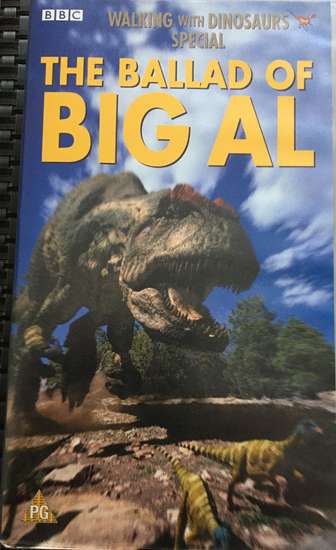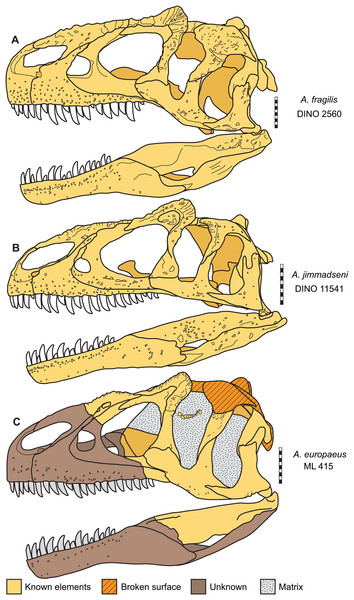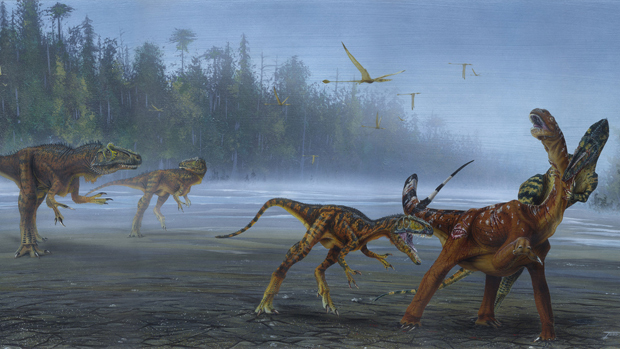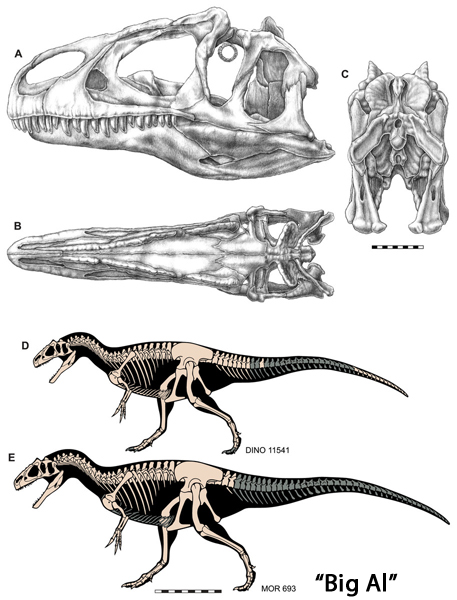A New Species of Allosaurus – Allosaurus jimmadseni
“Big Al” is Not Allosaurus fragilis but Allosaurus jimmadseni
A new species of North American Allosaurus has been described, the new dinosaur has been named Allosaurus jimmadseni, the species name honouring the late James H. Madsen Jr, Utah’s first state palaeontologist, who dedicated his career to excavating, preserving and studying the fossils found at the famous Cleveland-Lloyd Dinosaur Quarry.
In 1976, Madsen published a detailed monograph documenting the Allosaurus specimens found at this location, which is now the Jurassic National Monument complete with visitor centre. The monograph describing and illustrating the Quarry’s Allosaurus fossils is regarded as a seminal piece of work that strongly influenced the direction of research into theropod dinosaurs.
A Pack of Allosaurs (Allosaurus jimmadseni) Attacking a Juvenile Sauropod
Picture credit: Todd Marshall
“The Ballard of Big Al” – Allosaurus jimmadseni
Fans of the documentary “The Ballard of Big Al”, a spin-off programme to the famous “Walking with Dinosaurs” television series, made by the BBC Natural History Unit and Impossible Pictures that first aired over twenty years ago, will remember that this programme told the story of the life of an Allosaurus. The fossil specimen used as the basis for the story line, was found in the Howe Quarry (Wyoming), specimen number MOR 693. This was thought to represent an Allosaurus fragilis, but MOR 693 “Big Al” has now been assigned to this new species.
The Star of the Ballard of Big Al (MOR 693) Now Assigned to A. jimmadseni

Picture credit: Everything Dinosaur
New Allosaurus Species Based on Two Nearly Complete Fossil Skeletons
Writing in the academic journal PeerJ, the two authors of the scientific paper Mark Loewen, research associate at the Natural History Museum of Utah and associate professor in the Department of Geology and Geophysics at the University of Utah and co-worker Dan Chure, now retired, but formerly based at the Dinosaur National Monument, set out the case for the erection of a new species of Allosaurus. Between them they have studied virtually all the Allosaurus specimens in North American museums, a research project that has taken two decades and is still on-going.
The paper describing Allosaurus jimmadseni, is one of several papers that will be published by the pair. Future scientific papers will address post-cranial morphology and provide a further revision of the Allosaurus genus.
The new species of Allosaurus has been established based on the study of the “Big Al” specimen and specimen number DINO 11541 discovered by Dr George Engelmann (University of Nebraska), in 1990. Excavation continued at the Dinosaur National Monument site for several years, gradually exposing an almost complete articulated skeleton, but missing the skull. In the summer of 1996, University of Utah employee Ray Jones returned to the site and used a gamma X-ray detection device to locate the beautifully preserved cranium.
A Cast of the Specimen DINO 11541 Showing the Articulation and the Approximate position of the Skull
Picture credit: Dan Chure
Three Recognised Allosaurus Species
Since Allosaurus was first erected by the American palaeontologist Othniel Charles Marsh in 1877, numerous species have been named. However, in this research paper only three species are recognised – Allosaurus fragilis and Allosaurus jimmadseni in North America and Allosaurus europaeus from Europe. The researchers identified a number of unique characteristics (autapomorphies), in the specimens MOR 693 and DINO 11541 that led them to propose a new species. For example, the paired nasals of A. jimmadseni possess bilateral, thin, blade-like crests that run from the nostrils up the snout, ending at the apex of the eye socket. This feature is absent in Allosaurus fragilis.
A Life Reconstruction of Allosaurus jimmadseni

Picture credit: Andrey Atuchin
As a result of this new study, a number of other fossil specimens formerly placed within A. fragilis have been reassigned to A. jimmadseni.
Geologically the Oldest Species of Allosaurus
The “Big Al” fossil and specimen number DINO 11541 come from strata associated with the Lower Morrison Formation (Brushy Basin Member and Salt Wash Member respectively), as such, these animals are several million years older than those fossils now ascribed to Allosaurus fragilis.
Commenting on the significance of their extensive research, co-author Mark Loewen stated:
“Previously, palaeontologist thought there was only one species of Allosaurus in Jurassic North America, but this study shows that there were two species. The newly described Allosaurus jimmadseni evolved at least five million years earlier than its younger cousin, Allosaurus fragilis. The skull of Allosaurus jimmadseni is more lightly built than its later relative Allosaurus fragilis, suggesting a different feeding behaviour between the two.”
Comparing Allosaurus Skulls (Three Species Compared)

Picture credit: Chure and Loewen published in PeerJ
An Anagenetic Lineage?
This study suggests that Allosaurus jimmadseni fossils are found in the Salt Wash Member of the Morrison Formation in Utah and the lower part of the Brushy Basin Member of the Morrison Formation in Wyoming and South Dakota. If this is the case, then it raises the question whether the later A. fragilis evolved from the earlier Allosaurus jimmadseni. Did Allosaurus fragilis directly evolve from its older, close relative? If it did, then this is a form of evolution known as anagenesis – whereby one species gradually evolves into a new species over a long period of geological time.
An anagenetic lineage occurs when one population representing a single species, over thousands and thousands of years, gradually accumulates change. These changes eventually become sufficiently distinct from the earlier form that descendants can be labelled a new species.
Skull Drawings and Skeletal Reconstructions of Allosaurus jimmadseni
Picture credit: Chure and Loewen published in PeerJ with additional notation by Everything Dinosaur.
The illustration above shows stylised line drawings of the skull of Allosaurus jimmadseni in lateral, dorsal and posterior views along with skeletal reconstructions of DINO 11541 and “Big Al”. Scale bar (A-C) equals 10 cm and for D-E 1 metre.
Allosaurus, as the most common genus of Late Jurassic theropod in North America has played a significant role in helping palaeontologists to cement the phylogeny of Jurassic meat-eating dinosaurs. A revision of this key genus will probably have important consequences for future studies regarding the taxonomy of the Coelurosauria.
The scientific paper: “Cranial anatomy of Allosaurus jimmadseni, a new species from the lower part of the Morrison Formation (Upper Jurassic) of Western North America” by Daniel J. Chure and Mark A. Loewen published in PeerJ.
The Everything Dinosaur website: Everything Dinosaur.




